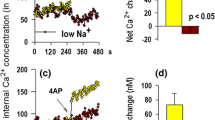Abstract
Our earlier observations showed thatl-lysine enhanced the activity of diazepam against seizures induced by pentylenetetrazol (PTZ), and increased the affinity of benzodiazepine receptor binding in a manner additive to that caused by γ-aminobutyric acid (GABA). The present paper provides additional evidence to show thatl-lysine has central nervous system depressant-like characteristics.l-lysine enhanced [3H]flunitrazepam (FTZ) binding in brain membranes was dose-dependent and stimulated by chloride, bromide and iodide, but not fluoride. Enhancement of [3H]FTZ binding byl-lysine at a fixed concentration was increased by GABA but inhibited by pentobarbital between 10−7 to 10−3M. While GABA enhancement of [3H]FTZ binding was inhibited by the GABA mimetics imidazole acetic acid and tetrahydroisoxazol pyridinol, the enhancement by pentobarbital andl-lysine of [3H]FTZ binding was dose-dependently increased by these two GABA mimetics. The above results suggest thatl-lysine and pentobarbital acted at the same site of the GABA/benzodiazepine receptor complex which was different from the GABA binding site. The benzodiazepine receptor antagonist imidazodiazepine Ro15-1788 blocked the antiseizure activity of diazepam against PTZ. Similar to pentobarbital, the anti-PTZ effect ofl-lysine was not blocked by Ro15-1788. Picrotoxinin and the GABA, receptor antagonist bicuculline partially inhibitedl-lysine's enhancement of [3H]FTZ binding with the IC50s of 2 μM and 0.1 μM, respectively. The convulsant benzodiazepine Ro5-3663 dose-dependently inhibited the enhancement of [3H]FTZ binding byl-lysine. This article shows the basic amino acidl-lysine to have a central nervous system depressant characteristics with an anti-PTZ seizure activity and an enhancement of [3H]FTZ binding similar to that of barbiturates but different from GABA.
Similar content being viewed by others
References
Karobath, M., and Sperk, G., 1979. Stimulation of benzodiazepine receptor binding by γ-aminobutyric acid, Proc. Nat. Acad. Sci. U.S.A. 76:1004–1006.
Tallman, J. F., Thomas, J. W., and Gallager, D. W., 1978. GABAergic modulation of benzodiazepine binding site sensitivity, Nature 274:384–385.
Leeb-Lundberg, J., Snowman, A., and Olsen, R. W., 1980. Barbiturate receptor sites are coupled to benzodiazepine receptors. Proc. Nat. Acad. Sci. U.S.A. 77:7468–7472.
Leeb-Lundberg, F., Snowman, A., and Olsen, R. W., 1981. Perturbation of benzodiazepine receptor binding by pyrazolopyridines involves picrotoxinin/barbiturate receptor sites. J. Neurosci. 1:471–477.
Skolnick, P., Moncada, V., Barker, J. L., and Paul, S. M., 1981. Bentobarbital: dual actions to increase brain benzodiazepine receptor affinity. Science 211:1448–1450.
Williams, M., and Risley, E. A., 1979. Enhancement of the binding of3H-diazepam by SQ 20009, a novel anxiolytic, γ-aminobutyric acid (GABA) and muscimol, Life Life Sci. 24:833–842.
Chang, Y. F., Hargest, V., and Chen, J. S., 1988. Modulation of benzodiazepine by lysine and pipecolic acid on pentylenetetrazol induced seizures.Life Sci. 43:1177–1188.
Chang, Y. F., and Myslinski, N. R., 1985. Effects ofl-lysine and its metabolites on pentylenetetrazol-induced seizures.Neurosci. Letter 59:79–84.
Chang, Y. F., Gao, X. M., and Chen, J. S., 1990. Enhancement of [3H]flunitrazepam binding and suppression of pentylenetetrazol-induced seizures byl-lysine are correlated, Eur. J. Pharmacol. in press.
Gao, X. M., and Chang, Y. F., 1989. Enhancement of benzodiazepine receptor bindingl-lysine is chloride dependent and due to increase in binding affinity, Eur. J. Pharmacol. 173:197–200.
Chang, Y. F., and Gao, X. M., 1990. Lysine enhancement of3H-flunitrazepam binding: interaction with GABA, pentobarbital and Ro5-3663, Eur. J. Pharmacol. 183:599–600.
Chang, Y. F., Hernandez, M. F., and Myslinski, N. R., 1981. Enhancement of hexobarbital sleep by lysine and its metabolites. Life Sci. 28:407–413.
Lowery, O. H., Rosebrough, N. J., Farr, A. L., and Randall, R. L., 1951. Protein measurement with the folin phenol reagent. J. Biol. Chem., 193:265–275.
Araki, T., Ito, M., and Oscarson, O. J., 1961. Anion permeability receptor binding by γ-aminobutyric acid, the synaptic and non-synaptic motoneurone membrane. J. Physiol. (London) 159:410–435.
Supavilai, P., and Karobath, M., 1979. Stimulation of benzodiazepine receptor binding by SQ20009 is chloride dependent and picrotoxin sensitive. Eur. J. Pharmacol. 60:111–113.
Chang, Y. F., 1978. Lysine metabolism in the rat brain: the pipecolic acid-forming pathway. J. Neurochem. 30:347–354.
Feigenbaum, P., and Chang, Y. F., 1986. pipecolic acid antagonizes barbiturate-induced binding to bovine brain membranes. Brain Res. 372:176–179.
Braestrup, C., Nielsen, M., Krogsgaard-Larsen, P., and Falch, E., 1979. Partial agonists for brain GABA/benzodiazepine receptor complex, Nature 280:331–333.
Karobath, M., Placheta, R., Lippitsch, M., and Krogsgaard-Larsen, P. 1979. Is stimulation of benzodiazepine receptor binding mediated by a novel GABA receptor? Nature 278:748–749.
Haefely, W. E., 1980. GABA and the anticonvulsant action of benzodiazepine and barbiturates. Brain Res. Bull. 5 suppl. 2:873–878.
Miller, L. G., Deutsch, S. I., Greenblatt, D. J., Paul, S. M., and Shader, R. I., 1988. Acute barbiturate administration increases benzodiazepine receptor binding in vivo. Psychopharmacol. 96:385–390.
Mehta, A. K., and Ticku, M. K., 1986. Comparison of anticonvulsant effect of pentobarbital and phenobarbital against seizures induced by maximal electroshock and picrotoxin in rats. Pharmacol. Biochem. Behav. 25:1059–1065.
Ramanjaneyulu, R., and Ticku M. K., 1984. Interactions of pentamethylene-tetrazole and tetrazole analogues with the picrotoxinin site of the benzodiazepine-GABA receptor-ionophore complex. Eur. J. Pharmacol. 98:337–345.
Rehavi, M. P., Skolnick, P., and Paul, S. M., 1982. Effects of tetrazole derivatives on [3H]diazepam binding in vitro: correlation with convulsant potency, Eur. J. Pharmacol. 78:353–356.
Takahama, K., Miyata, T., Okano, Y., Kataoka, M., Hitoshi, T., and Kase, Y., 1982. Potentiation of phenobarbital-induced anticonvulsant activity by pipecolic acid, Eur. J. Pharmacol. 81:327–331.
Grecksch, G., deCarvalho, L. P., Venault, P., Chapouthier, G., and Rossier, J., 1983. Convulsions induced by submaximal dose of pentylenetetrazol in mice are antagonized by the benzodiazepine antagonist Ro15-1788, Life Sci. 32:2579–2584.
Nutt, D. J., Cowen, P. J., and Little, H. J., 1982. Unusual interaction of benzodiazepine receptor antagonists. Nature 295:436–438.
Olsen, R. W., 1988. Barbiturates, Internat. Anesthes. Clin. 26:254–261.
Chang, Y. F., Y. Wang, R. K. Cauley, and X. M. Gao, 1993. Chronicl-lysine develops anti-pentelenetetrazol tolerance and reduces synaptic GABAergic sensitivity. Eur. J. Pharmacol. 233:209–217.
Author information
Authors and Affiliations
Rights and permissions
About this article
Cite this article
Chang, YF., Gao, XM. L-lysine is a barbiturate-like anticonvulsant and modulator of the benzodiazepine receptor. Neurochem Res 20, 931–937 (1995). https://doi.org/10.1007/BF00970739
Accepted:
Issue Date:
DOI: https://doi.org/10.1007/BF00970739



